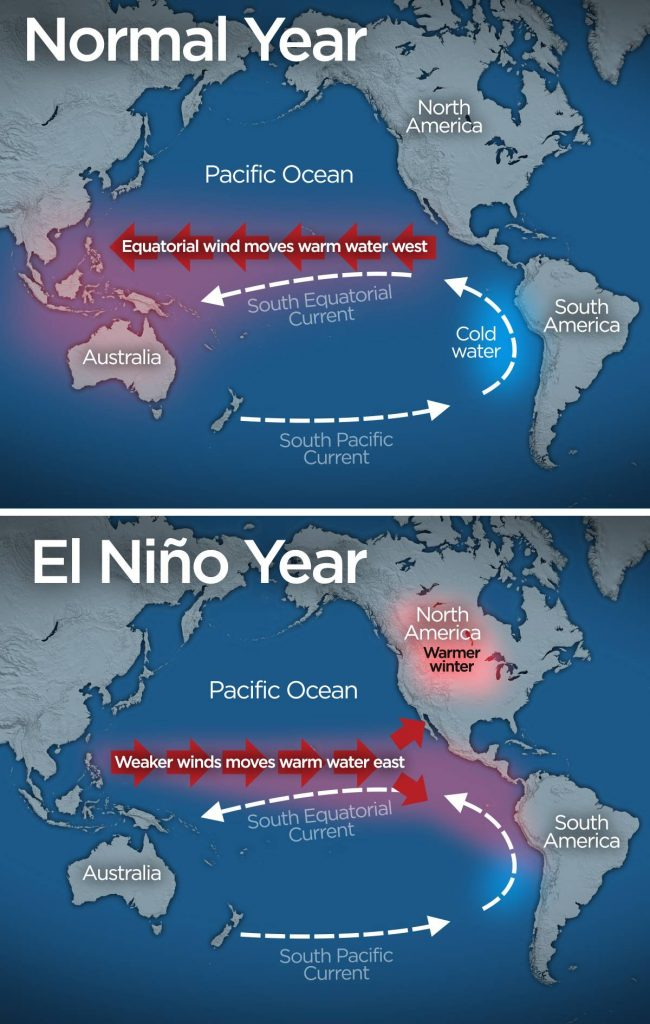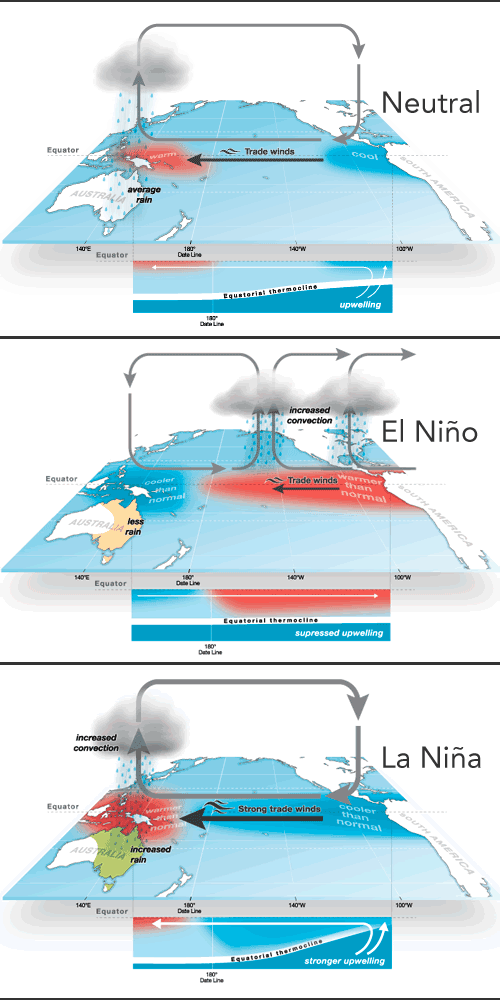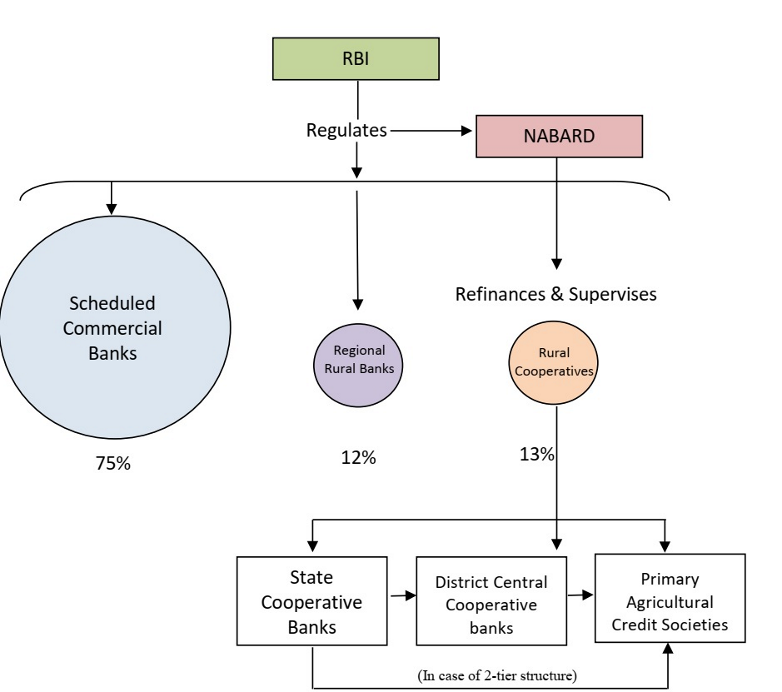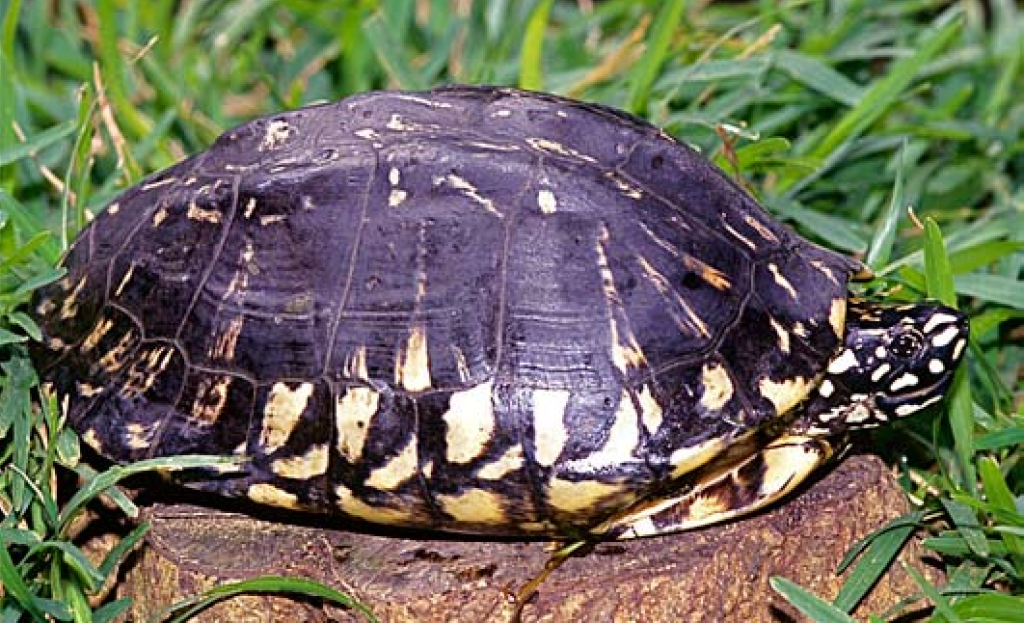CONTENTS
- El Niño
- NHAI’s First Sustainability Report
- RBI monetary policy update
- Primary Agricultural Credit Societies (PACS)
- Spotted Pond Turtles
- Pradhan Mantri Krishi Sinchayee Yojana (PMKSY)
El Niño
Context:
Recently, an unusual phenomenon is developing along the equatorial Pacific region, indicating the emergence of El Nino conditions in 2023. Experts warn that this simultaneous warming of the eastern and western regions of the equatorial Pacific, a trend last observed in 2009, could have severe implications for marine life worldwide.
Relevance:
GS-I: Geography (Climatology, Important Geophysical Phenomena), GS-III: Environment and Ecology (Environmental Pollution and Degradation, Impact of Climate Change)
Dimensions of the article:
- Causes for the Phenomenon
- El Niño
- La Niña
- ENSO
Causes for the Phenomenon:
- Eastern Pacific warming: The eastern Pacific is experiencing an increase in temperature, which would typically result in cooler temperatures in the western Pacific.
- Basin scale warming: Global warming has led to warming across the entire tropical Pacific region, affecting the temperature patterns.
- Global warming and natural variability: The phenomenon can be attributed to a combination of global warming in the Pacific and other modes of natural variability within the climate system.
- Transition from La Niña to El Niño: The transition from a La Niña winter to an El Niño summer, as part of the El Niño-Southern Oscillation (ENSO) cycle, could also be a triggering factor for the observed phenomenon.
El Niño
- El Niño is the warm phase of the El Niño–Southern Oscillation (ENSO) and is associated with a band of warm ocean water that develops in the central and east-central equatorial Pacific (between approximately the International Date Line and 120°W), including the area off the Pacific coast of South America.
- The ENSO is the cycle of warm and cold sea surface temperature (SST) of the tropical central and eastern Pacific Ocean.
- El Niño is accompanied by high air pressure in the western Pacific and low air pressure in the eastern Pacific.
- During the development of El Niño, rainfall develops between September–November.
- The cool phase of ENSO is La Niña, with SSTs in the eastern Pacific below average, and air pressure high in the eastern Pacific and low in the western Pacific.
- The ENSO cycle, including both El Niño and La Niña, causes global changes in temperature and rainfall.

La Niña
- La Niña is a coupled ocean-atmosphere phenomenon that is the colder counterpart of El Niño, as part of the broader El Niño–Southern Oscillation (ENSO) climate pattern.
- is a coupled ocean-atmosphere phenomenon that is the colder counterpart of El Niño, as part of the broader El Niño–Southern Oscillation (ENSO) climate pattern.
- During a period of La Niña, the sea surface temperature across the equatorial Eastern Central Pacific Ocean will be lower than normal by 3 to 5 °C (5.4 to 9 °F).
- An appearance of La Niña persists for at least five months.
- It has extensive effects on the weather across the globe, particularly in North America, even affecting the Atlantic and Pacific hurricane seasons, in which more tropical cyclones occur in the Atlantic basin due to low wind shear and warmer sea surface temperatures, while reducing tropical cyclogenesis in the Pacific Ocean.
- La Niña is a complex weather pattern that occurs every few years, as a result of variations in ocean temperatures in the Equatorial Pacific.
- It occurs as strong winds blow warm water at the ocean’s surface from South America across the Pacific Ocean towards Indonesia.
- As this warm water moves west, cold water from the deep sea rises to the surface near South America.
- As a result, it is considered to be the cold phase of the broader El Niño–Southern Oscillation weather pattern, as well as the opposite of El Niño weather pattern.
- La Niña impacts the global climate and disrupts normal weather patterns, which as a result can lead to intense storms in some places and droughts in others.

ENSO
- El Nino and the Southern Oscillation, also known as ENSO is a periodic fluctuation in sea surface temperature (El Niño) and the air pressure of the overlying atmosphere (Southern Oscillation) across the equatorial Pacific Ocean.
- El Nino and La Nina are complex weather patterns resulting from variations in ocean temperatures in the Equatorial Pacific Region. They are opposite phases of what is known as the ENSO cycle.
- El Nino and La Nina episodes typically last nine to 12 months, but some prolonged events may last for years.
-Source: The Hindu
NHAI’s First Sustainability Report
Context:
NHAI has published its First Sustainability Report for the FY 2021-22, which sheds light on the organization’s governance structure, stakeholders, environmental initiatives, and social responsibility efforts. The report aligns with the guidelines set by the Global Reporting Initiative (GRI) and is expected to facilitate the attraction of “Green Finance” for infrastructure financing.
Relevance:
GS III: Infrastructure
Dimensions of the Article:
- Key Findings of the Report
- About Global Reporting Initiative
- About National Highways Authority of India (NHAI)
Key Findings of the Report:
- Digitization of highway network: NHAI has developed the ‘Data Lake Tool’ to digitize the highway network in India, enabling effective management of the vast amount of data generated by NHAI’s infrastructure.
- Reduction in emissions and fuel consumption: NHAI has achieved a reduction of 18.44% in direct emissions and 9.49% in fuel consumption from FY 2019-20 to 2021-22.
- Decline in GHG emissions: Greenhouse gas (GHG) emissions from energy consumption, operations, transport, and travel witnessed a decline of 9.7% in FY 2020-21 and 2% in FY 2021-22.
- Use of recycled materials: NHAI has been using recycled materials such as fly-ash, plastic waste, recycled asphalt (RAP), and recycled aggregates (RA) for national highway construction.
- Wildlife protection and conservation: Over 100 wildlife crossings have been created in three years across 20 states to reduce man-animal conflicts and ensure wildlife protection and conservation.
- Eco-friendly national highways: NHAI has undertaken plantation drives and planted approximately 2.74 crore saplings till 2021-22 to develop eco-friendly national highways and offset direct emissions from vehicles.
- Increase in women employment and employment of marginalized communities: NHAI has observed a steady increase in female hiring by 7.4% and an overall increase of 3% in the employment of marginalized communities over the last three years.
About Global Reporting Initiative
- The Global Reporting Initiative (GRI) is an independent, international organization that supports businesses and organizations in taking responsibility for their environmental, social, and governance impacts.
- GRI provides a framework and guidelines for companies and organizations to report on their economic, environmental, social, and governance performance.
- By using the GRI framework, organizations can measure and disclose their sustainability efforts and performance.
- The GRI Secretariat is based in Amsterdam, the Netherlands, and works with various stakeholders to promote transparency and sustainability reporting worldwide.
About National Highways Authority of India (NHAI):
NHAI is the premier organization in India responsible for the development, maintenance, and management of National Highways. Here are some key facts about NHAI:
- NHAI was established in February 1995 under the National Highways Authority of India Act, 1988.
- It is a statutory body under the administrative control of the Ministry of Road Transport and Highways.
- NHAI consists of a full-time Chairman and not more than five full-time members and four part-time members who are appointed by the Central Government.
- The part-time members are the Secretary (RT&H), Secretary (Expenditure), Secretary (Planning), and DG (RD) & SS.
- NHAI has several wings at its headquarters, including technical, finance, administrative, and vigilance wings.
-Source: Indian Express
RBI Monetary Policy Update
Context:
The Monetary Policy Committee (MPC) of the Reserve Bank of India (RBI) decided to keep the policy repo rate under the liquidity adjustment facility (LAF) unchanged.
Relevance:
GS III: Indian Economy
Dimensions of the Article:
- Key Details
- About Monetary Policy Committee (MPC)
Key Details:
Repo Rate:
- The repo rate is now set at 6.50 percent.
- It represents the rate at which the Reserve Bank of India lends money to commercial banks in case of a shortage of funds.
Standing Deposit Facility (SDF):
- The SDF rate stands at 6.25 percent.
- SDF is a liquidity window provided by the RBI for banks to park excess liquidity without the need for collateral.
Marginal Standing Facility (MSF) Rate:
- The MSF rate is set at 6.75 percent.
- MSF serves as a borrowing window for banks from the central bank during situations when inter-bank liquidity is completely depleted.
Bank Rate:
- The Bank Rate is currently at 6.75 percent.
- It is the rate at which the central bank lends funds to commercial banks.
- It is important to note that while the Repo Rate and Bank Rate are different, as the Repo Rate is for short-term borrowing against securities, the Bank Rate is the rate charged for lending funds to commercial banks.
About Monetary Policy Committee (MPC)
- The Monetary Policy Committee (MPC) is the body of the RBI, headed by the Governor, responsible for taking the important monetary policy decisions about setting the repo rate.
- Repo rate is ‘the policy instrument’ in monetary policy that helps to realize the set inflation target by the RBI (at present 4%).
Membership of the MPC
- The Monetary Policy Committee (MPC) is formed under the RBI with six members.
- Three of the members are from the RBI while the other three members are appointed by the government.
- Members from the RBI are the Governor who is the chairman of the MPC, a Deputy Governor and one officer of the RBI.
- The government members are appointed by the Centre on the recommendations of a search-cum-selection committee which is to be headed by the Cabinet Secretary.
Objectives of the MPC
Monetary Policy was implemented with an initiative to provide reasonable price stability, high employment, and a faster economic growth rate.
The major four objectives of the Monetary Policy are mentioned below:
- To stabilize the business cycle.
- To provide reasonable price stability.
- To provide faster economic growth.
- Exchange Rate Stability.
-Source: Indian Express
Primary Agricultural Credit Societies (PACS)
Context:
Ministry of Cooperation issued a statement that Primary Agricultural Credit Societies (PACS) can also be employed as drone entrepreneurs for spraying fertilisers and pesticides.
Relevance:
GS III- Indian Economy
Dimensions of the Article:
- About Primary agricultural credit societies
- Objectives of PACS
- Functions of PACS
About Primary agricultural credit societies:
- PACS is the smallest cooperative credit institution in India and a basic unit.
- The initial Primary Agricultural Credit Society (PACS) was founded in 1904.
- It has a grassroots effect (gram panchayat and village level).
- PACS serves as the last point of contact between the primary borrowers, or rural residents, and the higher agencies, such as the Central Cooperative Bank, State Cooperative Bank, and Reserve Bank of India.
- PACS are governed by the RBI and registered under the Co-operative Societies Act.
- The “Banking Regulation Act-1949” and the “Banking Laws (Co-operative societies) Act 1965” are in charge of them.

Objectives of PACS
- To raise capital for the purpose of making loans and supporting members’ essential activities.
- To collect deposits from members with the goal of improving their savings habit.
- To supply agricultural inputs and services to members at reasonable prices,
- To arrange for the supply and development of improved breeds of livestock for members.
- To make all necessary arrangements for improving irrigation on land owned by members.
- To encourage various income-generating activities through supply of necessary inputs and services.
Functions of PACS
- PACS typically offer the following services to their members:
- Input facilities in the form of a monetary or in-kind component
- Agriculture implements for hire
- Storage space
-Source: Indian Express
Spotted Pond Turtles
Context:
Three persons engaged as mahouts (keepers and drivers of an elephant) in the Kaziranga National Park and Tiger Reserve, Assam, have been arrested for capturing and consuming spotted pond turtles, a rare species of a freshwater turtle.

Relevance:
GS III: Environment and Ecology
Dimensions of the Article:
- Spotted Pond Turtles
- Kaziranga National Park
Spotted Pond Turtles:
- Spotted pond turtles (Geoclemys hamiltonii) are characterized by yellow or white spots on their black heads, legs, and tails.
- They have large heads, short snouts, and webbed feet for swimming.
- Also known as Black Pond Turtles, Black Spotted Turtles, and Hamilton’s Terrapin.
- They regulate their body temperature by basking in the sun and require warm water and suitable basking areas.
- When retreating into their shells, they produce a soft croak.
- Found in large, deep rivers in India, Assam, Pakistan, and Bangladesh.
- Distribution in India includes the northern, northeastern, and some central regions.
- Spotted pond turtles are primarily carnivorous and feed on aquatic invertebrates.
- These turtles exhibit crepuscular behavior, being most active during twilight hours (dusk and dawn).
Conservation Status:
- Classified as endangered by the International Union for Conservation of Nature (IUCN).
- Listed under Appendix I of the Convention on International Trade in Endangered Species of Wild Fauna and Flora (CITES).
Kaziranga National Park
- Kaziranga National Park is a national park in the Golaghat, Karbi Anglong and Nagaon districts of the state of Assam.
- It is a World Heritage Site and hosts two-thirds of the world’s great one-horned rhinoceroses.
- Kaziranga is recognized as an Important Bird Area by BirdLife International for conservation of avifaunal species.
- Along with the iconic Greater one-horned rhinoceros, the park is the breeding ground of elephants, wild water buffalo, and swamp deer.
- Over the time, the tiger population has also increased in Kaziranga, and that’s the reason why Kaziranga was declared as Tiger Reserve in 2006.
- Due to the difference in altitude between the eastern and western areas of the park, here one can see mainly four types of vegetation’ like alluvial inundated grasslands, alluvial savanna woodlands, tropical moist mixed deciduous forests, and tropical semi-evergreen forests.
- Kaziranga is a vast expanse of tall elephant grass, marshland, and dense tropical moist broadleaf forests, criss-crossed by four major rivers, including the Brahmaputra, and the park includes numerous small bodies of water.
- Kaziranga has flat expanses of fertile, alluvial soil, formed by erosion and silt deposition by the River Brahmaputra.
- The history of Kaziranga as a protected area can be traced back to 1904 when the wife of the Viceroy of India, Lord Curzon visited the area and persuaded to take measures to protect rhinoceros in the area.
-Source: The Hindu
Pradhan Mantri Krishi Sinchayee Yojana (PMKSY)
Context:
Under the Pradhan Mantri Krishi Sinchayee Yojana, Aadhaar cards being misused to create beneficiaries under Per Drop More Crop Scheme in Jharkhand state has been revealed.
Relevance:
GS II: Government policies and Interventions
Dimensions of the Article:
- About Pradhan Mantri Krishi Sinchayee Yojana
- Objectives
About Pradhan Mantri Krishi Sinchayee Yojana (PMKSY):
- Pradhan Mantri Krishi Sinchayee Yojana (PMKSY) is a Centrally Sponsored Scheme (Core Scheme) launched in 2015.
- The funding pattern for the scheme is 75:25 between the Central and State governments. However, for the north-eastern region and hilly states, the funding pattern is 90:10.
- The scheme aims to benefit approximately 22 lakh farmers, including 2.5 lakh scheduled caste farmers and two lakh scheduled tribe farmers.
- In 2020, the Ministry of Jal Shakti launched a mobile application for Geo-Tagging of the components of projects under PMKSY. This application helps in tagging and monitoring the various components of irrigation projects under the scheme.
It was created by merging the following schemes:
- Accelerated Irrigation Benefit Programme (AIBP) under the Ministry of Jal Shakti (formerly Ministry of Water Resources, River Development & Ganga Rejuvenation).
- Integrated Watershed Management Programme (IWMP) under the Department of Land Resources, Ministry of Rural Development.
- On-Farm Water Management (OFWM) under the Department of Agriculture and Cooperation (DAC).
- Implementation: Decentralized implementation through State Irrigation Plan and District Irrigation Plan.
PMKSY consists of two major components:
- Accelerated Irrigation Benefit Programme (AIBP): This component focuses on creating irrigation infrastructure and increasing water availability for agricultural purposes.
- Har Khet Ko Pani (HKKP): This component includes four sub-components:
- Command Area Development & Water Management (CAD&WM)
- Surface Minor Irrigation (SMI)
- Repair, Renovation, and Restoration (RRR) of Water Bodies
- Ground Water (GW) Development
Additionally, PMKSY also includes two other components:
- Per Drop More Crop (PDMC) component: Implemented by the Department of Agriculture and Farmers Welfare, this component aims to improve water use efficiency and promote efficient irrigation practices.
- Watershed Development component (WDC): Implemented by the Department of Land Resources, this component focuses on integrated watershed management for sustainable agriculture and rural livelihoods.
Objectives:
- Convergence of investments in irrigation at the field level.
- Expansion of cultivable area under irrigation.
- Improving on-farm water use efficiency to reduce water wastage.
- Promoting the adoption of precision irrigation and other water-saving technologies
- Improve aquifer recharge and sustainable water conservation practices by examining the potential of using treated municipal water for peri-urban agriculture.
- Attract more private investment in precision irrigation systems.
-Source: Indian Express



